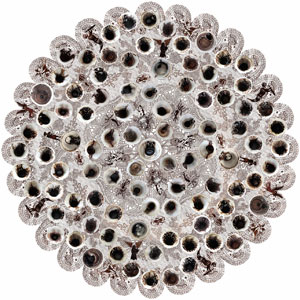Lara Baladi: Diary of the Future
Gallery Isabelle van den Eynde
Dubai, United Arab Emirates
May 3–June 10, 2010
Originally printed in the July/August 2010 issue of Afterimage
 As one leisurely finishes a cup of Turkish coffee, a dense liquid known for its thick, molasses-like qualities, the saucer is placed on the top of the cup and is turned upside down. The cup is rotated clockwise three times. The coffee drinker makes a wish and places the cup and saucer on the ground or a table to cool and dry while casual talk continues. Afterward, a person with a trained eye—usually a friend or relative—will read the fortune of the drinker by using the coffee residue that forms abstract shapes and patterns in the cup. This ceremony was the foundation for Lara Baladi’s recent exhibition “Diary of the Future” at the Gallery Isabelle van den Eynde in Dubai.
As one leisurely finishes a cup of Turkish coffee, a dense liquid known for its thick, molasses-like qualities, the saucer is placed on the top of the cup and is turned upside down. The cup is rotated clockwise three times. The coffee drinker makes a wish and places the cup and saucer on the ground or a table to cool and dry while casual talk continues. Afterward, a person with a trained eye—usually a friend or relative—will read the fortune of the drinker by using the coffee residue that forms abstract shapes and patterns in the cup. This ceremony was the foundation for Lara Baladi’s recent exhibition “Diary of the Future” at the Gallery Isabelle van den Eynde in Dubai.
Entering the exhibition, the work appeared to be playful and inviting with its tightly cropped macro imagery of coffee residue, forming sensuous and beautifully abstracted forms. Yet, upon closer observation of the work, one senses melancholy. Consisting of five works—three large-scale and two smaller-scale, no larger than four feet wide—the exhibition used the coffee fortune-telling ritual to reexamine notions of memory, loss, and destiny.
Relative Destinies (2010) is a large-scale work (roughly thirteen feet by thirteen feet) that envelops the viewer with its grid-like structure and contains 192 stunningly composed photographs of Turkish coffee residue—creating an altar-like visage. Beyond its pleasing formal qualities, the piece raises questions about fate and existence.
According to the catalog, coffee readings became part of Baladi’s Sunday ritual when she moved to Cairo in 1997. Her grandmother would invite family and friends over for lunch on Sunday, and, as part of the gathering, they would conduct coffee readings. When her father became ill and returned to Cairo in 2007 to die, Baladi asked her father’s visitors to partake in the Turkish coffee reading ritual—following her succinct instructions for proper reading—and she then labeled and dated the cups.
Chronologie (2008) is the documentation of the ritual, from her father’s arrival in Cairo to his eventual death, made into an ambitious large-scale work. The first image in the chronologically organized grid of photos begins with a robust remnant of Turkish coffee on a saucer—still fresh, the rich, dark, and pungent coffee leaves a remarkably potent residue that creates an abstract form. The second image documents Baladi’s inclusion in the ritual as her name is prominently placed in front of the lens with the date of participation. Throughout the work, viewers are introduced to fragments of the ritual—from a cropped photo of a women’s leg beside a set of four spent coffee cups and saucers, to close-up images of dry and cracked Turkish coffee sludge. The subtle chronological placement leads one to the eventual image of an ethereal-like abstraction of coffee residue, which appears to allude to her father’s passing.
Another large-scale work, Rose (2010), is a digital collage printed on large bands of paper that uses a doily-like structure for investigation and metaphor. Strategically placed teacups—as well as images of skeletons, grim reapers, lovers, and cherubs—are integrated in the doily’s pattern to reinforce its balance and symmetry. Pretty, protective, and ornamental, the doily is reminiscent of the past, while the teacups filled with remnants of consumed coffee intimate one’s future or fate, and the cherubs, skeletons, and lovers signify the life cycle.
While still retaining her playful approach, gone is the humor found in Baladi’s earlier work such as “Al Fanous Al Sehry” (2002), which also comments on the life cycle. The installation, which consisted of a large eight-pointed star steel structure containing a border of light boxes along its perimeter illuminates a series of x-ray photographs of a pregnant doll repeatedly giving birth sequentially aligned, metaphorically questioning the role of the woman. In her new body of work, the humor found in this earlier piece is replaced with thoughtful deliberation.
While the two smaller works, The Eye of Adam (2010) and La Mére Noire (2010), are equally engaging, it is the large-scale works, with their Rothko-like qualities, that speak more clearly to the viewer. They invite and envelop the viewer into a world of contemplation and reflection.
In hindsight, Baladi’s previous solo exhibition in 2008, “Surface of Time,” also at the Gallery Isabelle van den Eynde (formerly known as B21), now appears to have been a transitional exhibition from her philosophically driven, playful, and sometimes cynical work to a more introspective and reflective body of work that looks at the most primary consequences of life: death and loss.